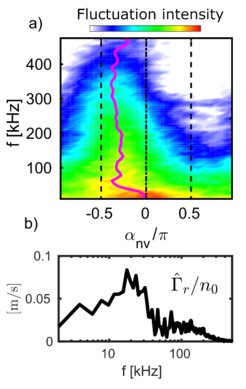Improving understanding of turbulence behavior in the plasma boundary with a high heat flux ball-pen probe head
Turbulence plays an ambiguous role in tokamaks. While low turbulence levels are necessary to achieve the high-confinement regime (H-mode), some degree of turbulence in the scrape-off layer can be beneficial for power exhaust through increasing radial transport and thereby spreading heat over a wider area.

a) distribution of cross-phase between density and radial velocity fluctuation as a function of frequency (the magenta line represents the average cross-phase).
b) radial transport decomposed in frequency and normalized by the local average density.
Therefore the proper understanding of turbulence properties is fundamental if one wants to make reliable predictions of the plasma power loaded area in future machines, such as ITER.
Plasma density and temperature perturbations are often damped by the nearly unhindered motion of electrons along the field lines, which assures the local plasma neutrality. When this response is not fast enough (e.g., when the plasma is too collisional), charge accumulation can create local electric fields and E×B drift. High radial transport levels arise when the high-density perturbation is in phase with the velocity fluctuation pointing radially outward. Therefore, turbulence characterization requires measuring electric field fluctuations with high spatiotemporal resolution at the ‘hot’ boundary between scrape-off layer and confined plasma.
A new high heat flux probe head composed of ball-pen and Langmuir pins was built to withstand high-heat flux environments. Besides, the ball-pen pins allow to measure electric field fluctuations more precisely. The simultaneous measurement of plasma density and radial velocity carried out in ASDEX Upgrade reveals that the major contribution for the turbulent transport comes from low-frequency fluctuations (below 40 kHz) characterized by favorable phase relations between density and radial velocity (see Figure a) and b)).
The respective publication of this work can be found here:
